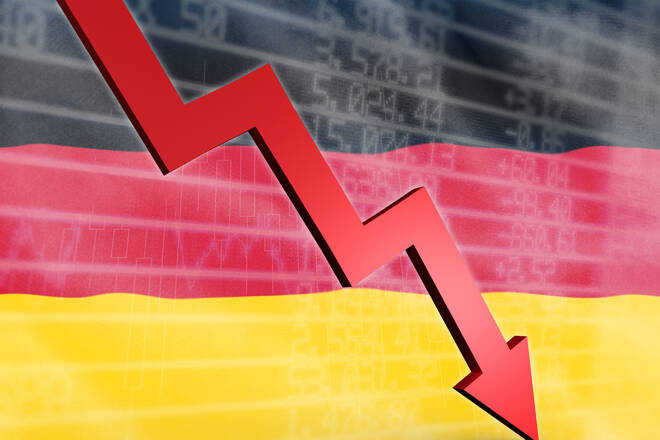Advertisement
Advertisement
European Equities: German Retail Sales and Corporate Earnings in Focus
By:
It's a relatively quiet day ahead on the economic calendar. German retail sales and U.S ISM Manufacturing PMIs and corporate earnings will influence, however.
Economic Calendar
Monday, 1st November
German Retail Sales m/m (Sep)
Tuesday, 2nd November
Spanish Manufacturing PMI (Oct)
Italian Manufacturing PMI (Oct)
French Manufacturing PMI (Oct) Final
German Manufacturing PMI (Oct) Final
Eurozone Manufacturing PMI (Oct) Final
Wednesday, 3rd November
Eurozone Unemployment Rate (Sep)
Thursday, 4th November
German Factory Orders (MoM) (Sep)
Spanish Services PMI (Oct)
Italian Services PMI (Oct)
French Services PMI (Oct) Final
German Services PMI (Oct) Final
Eurozone Markit Composite PMI (Oct) Final
Eurozone Services PMI (Oct) Final
Friday, 5th November
German Industrial Production (MoM) (Sep)
French Non-Farm Payrolls (QoQ) (Q3)
German IHS Markit Construction PMI (Oct)
Eurozone Retail Sales (MoM) (Sep)
The Majors
It was another mixed day for the European majors on Friday.
The DAX30 slipped by 0.05% to buck the trend. Finding support, however, were the CAC40 and the EuroStoxx600, which ended the day up by 0.38% and by 0.07% respectively.
It was a busier day on the economic calendar, with 3rd quarter GDP numbers for member states and the Eurozone and inflation in focus.
A further pickup in inflationary pressure across the Eurozone and disappointing 3rd quarter GDP numbers from Germany weighed on the DAX30.
Better than expected 3rd quarter GDP numbers from France supported the CAC40 and the EuroStoxx600, however.
From the U.S, personal spending and inflation figures were also market friendly on the day.
The Stats
Key stats included 3rd quarter GDP numbers for France, Germany, Spain, and the Eurozone.
Member States
In the 3rd quarter, the Spanish economy grew by 2.00% quarter-on-quarter versus a forecasted 2.7%. The economy had expanded by 1.1% in the previous quarter.
The French economy grew by 3.0% in the quarter versus a forecasted 2.1%. In the 2nd quarter, the economy had expanded by 1.2%.
For Germany, the economy grew by 1.8% quarter-on-quarter, falling short of a forecasted 2.2%. In the previous quarter, the economy had grown by 1.9%.
The Eurozone
In the 3rd quarter, the Eurozone economy grew by 2.2% quarter-on-quarter. The economy had expanded by 2.1% in the 2nd quarter. Year-on-year, the economy expanded by 3.7%.
According to Eurostat,
Among member states, with data available for the 3rd quarter:
- Austria (+3.3%) recorded the highest increase, quarter-on-quarter, followed by France (+3.0%) and Portugal (+2.9%).
- Latvia (+0.3%) and Lithuania (+0.0%) recorded the lowest GDPs.
While the GDP numbers were mixed, inflation figures raised yet more red flags.
According to prelim figures, the Eurozone’s annual rate of inflation accelerated from 3.4% to 4.1%. Economists had forecasted a pickup to 3.7%.
According to Eurostat,
- Energy is expected to have the highest annual rate in October of 23.5% compared with 17.6% in September.
- For services, the annual rate of inflation is expected to be 2.1%. (Sept: 1.7%).
- The annual rate of inflation for non-energy industrial goods is expected to soften to 2.0% in October (Sept: 2.1%).
- Food, alcohol, & tobacco is expected to see the annual rate of inflation stable at 2.0%.
Month-on-month, consumer prices rose by 0.8% following a 0.5% increase in September.
From the U.S
Personal spending and inflation were key stats on the day.
In September, personal spending rose by 0.6%. Spending had increased by 1.0% in August.
Inflationary pressures persisted, however. The Core PCE Price Index was up 3.6% year-on-year. In August, the Core PCE Price Index had also been up 3.6%, year-on-year.
The Market Movers
For the DAX: It was another mixed day for the auto sector on Friday. Daimler rallied by 2.39% to lead the way, with Continental rising by 0.75%. Volkswagen fell by 1.15%, however, with BMW ending the day down by 0.18%.
It was a bullish day for the banks. Deutsche Bank rose by 0.86%, with Commerzbank rallying by 2.30%.
From the CAC, it was a relatively bearish day for the banks. Soc Gen rallied by 1.76%, Credit Agricole and BNP Paribas rose by 0.68% and by 0.77% respectively.
It was a mixed day for the French auto sector, however. Stellantis NV fell by 0.21%, while Renault rose by 0.45%.
Air France-KLM rallied by 3.12%, while Airbus SE ended the day down by 1.25%.
On the VIX Index
It was a 2nd consecutive day in the red for the VIX on Friday.
Following a 2.65% decline on Thursday, the VIX fell by 1.63% to end the day at 16.26.
The NASDAQ rose by 0.33%, with the Dow and the S&P500 gaining 0.25% and 0.19% respectively.
The Day Ahead
It’s a relatively quiet day ahead on the Eurozone’s economic calendar. German retail sales figures will be in focus going into the European open.
Also in focus will be U.S, ISM Manufacturing PMI numbers for October.
Going into the European open, manufacturing PMI numbers from China will set the tone.
From the weekend, the NBS private sector PMIs failed to impress. In October, the Manufacturing PMI fell from 49.6 to 49.2. The Non-Manufacturing PMI declined from 53.2 to 52.4.
The market’s preferred Caixin Manufacturing PMI, due out early this morning, will be key. Expect weaker numbers to test support for riskier assets.
Key earnings including earnings for Audi AG will also influence.
The Futures
In the futures markets, at the time of writing, the Dow Mini was up by 78 points.
For a look at all of today’s economic events, check out our economic calendar.
About the Author
Bob Masonauthor
With over 28 years of experience in the financial industry, Bob has worked with various global rating agencies and multinational banks. Currently he is covering currencies, commodities, alternative asset classes and global equities, focusing mostly on European and Asian markets.
Advertisement
